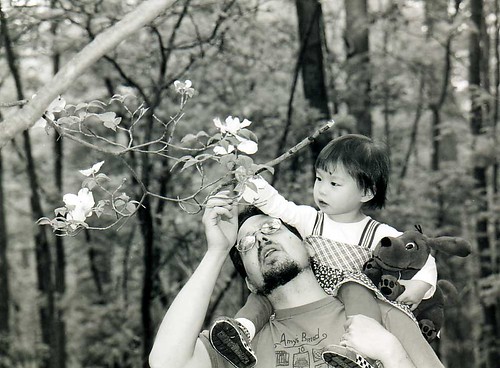|
|
Wednesday, December 10th, 2008
Last night I was watching Herzog's short documentaries; one of them is How Much Wood Would a Woodchuck Chuck... -- Beobachtungen zu einer neuen Sprache, which is a record of the 1976 National Livestock Auctions championships. Interesting and fun! The auctioneer's cant always gets my blood going. (The above song is "The Auctioneer" by The Spark Gap Wonder Boys -- the movie has a similar thing going on, but even better because there are so many different auctioneers.)Well -- a lot to say about this film but I didn't really get any of it sorted out. There are things that remind me of Stroszek, most obviously the auction scene but other stuff too, like the lovely performance of "Country Roads" midway through. The main thing was, I thought this documentary was a distillation of Herzog's fascination with language and idiom -- my favorite part was the beginning, when Herzog was interviewing some of the contestants. The camera just hung on their bodies and heads and watched them talking. They talk about how they got into auctioneering and how they learned the cant. Bonus that they came from a lot of different places in North America so you got to watch how their inflecions come through in the cant.
posted evening of December 10th, 2008: Respond
➳ More posts about How Much Wood Would a Woodchuck Chuck...
|  |
Tuesday, December 9th, 2008
Bill of Orbis Tertius Quintus gives my thoughts on identification with authors a sympathetic link. Nice to see them framed by someone else -- gives me something to think about.
posted evening of December 9th, 2008: 3 responses
➳ More posts about Readings
|  |
|
Returned to Pedro's house in Orce, the three travellers watch Gibraltar slipping past on TV, and get a glimpse of José's starlings -- he admits he had forgotten them on the drive. There they are now, as Unamuno described them, his swarthy face cupped in the palms of his hands, Fix your eyes where the lonely sun sets in the immense sea, all nations with the sea to the west do the same,... Interesting -- what poem of Unamuno's is this? It's a beautiful line. Google gives no hits for the phrase, "Fix your eyes where the lonely sun sets in the immense sea" -- perhaps it has not been translated precisely this way before. What is hellish about Orce? Repeatedly in the text, Saramago is describing this town as the abode of the Devil -- pictures of the region I can find on the internet seem pretty idyllic though. This is where Pedro asks to join the travellers in their journey.
posted evening of December 9th, 2008: Respond
➳ More posts about The Stone Raft
|  |
Sunday, December 7th, 2008

They are seated on the ground, under a Cordoban olive tree, the kind that, according to the popular quatrain, makes the oil yellow, as if olive oil weren't yellow, or only occasionally slightly greenish...
Any ideas what the popular verse referenced is? Google's not doing much for me. Is Cordoban/Cordovan a variety of olive in addition to being a place where olives are grown?
posted evening of December 7th, 2008: Respond
➳ More posts about José Saramago
|  |
|
...I don't know -- hard to think of a clever title. Anyway: It's trite for adults to complain about the lameness of kids' movies so I'll just say that I found Madagascar II, to which I chaperoned Sylvia and Kaydi this afternoon, even worse than the original film. The animation was pretty mediocre and the plot points a dreadful hodgepodge of mass-produced sentimentality. But what about this: There was a preview for DreamScape's Monsters vs. Aliens. OK -- looks kind of silly but in good fun. But why in hell does the evil leader of the aliens look like a caricature of Barack Obama? Am I paranoid and inventing this? Trailer here. The resemblance does not seem as obvious on rewatching as it did in the theater.
posted evening of December 7th, 2008: Respond
➳ More posts about The Movies
|  |
|
I sort-of knew that Spain does not have sovereignty over Gibraltar. I would have needed some kind of prompt to remember it though. Saramago gave me the prompt today, when he had Gibraltar break away from the Iberian peninsula, remaining with Europe as Iberia floats away. Strikes me as hilarious, to have the supernatural tectonic forces in the novel respect political boundaries rather than just physical ones. (Taking the Pyrenees as a natural physical boundary.) So: it was interesting to see the Spaniards celebrating the departure of Gibraltar. I got the sense this passage was intended in fun -- I am curious to know what the Spanish national attitude toward British sovereignty there is. (Another point of sovereignty I found out about in today's reading is the dispute over Olivenza in Badajoz, which Portugal does not officially recognize the Spanish claim to. Joachim Sassa's car is not interested in seeing Gibraltar, since as a Portuguese car, "his ancient grief is Olivença, and this road does not lead there.")
Work on the Stone Raft Map proceeds apace -- this is really fun and will make a useful companion to the book.
posted afternoon of December 7th, 2008: 2 responses
|  |
Saturday, December 6th, 2008
Near the end of the fifth chapter of The Stone Raft, José and Joachim are in a tourist office in Granada getting directions from the newly introduced* Maria Dolores, who describes herself as "an anthropologist by training and a militant feminist by inclination." She asks if they are doing research on Orce Man, the fossilized skull discovered "some years ago" which is the oldest human fossil found yet in Europe. There is an article about Orce Man at talkorigins.org which says it was discovered in 1982 and that in 1984 a symposium about it was cancelled when French scientists suggested the skull was probably not human. So perhaps this narrows down the setting of the novel to sometime around late 1983 or early 1984? It was published in 1986.
 *(Anyway I don't think she was mentioned in the first chapter. Should go back and double-check.)
posted evening of December 6th, 2008: Respond
|  |
 Citroën Deux Cheveaux -- Joachim's wheels. I'm trying to embed it here but haven't quite figured that out yet. Embedded map is below the fold.
posted evening of December 6th, 2008: Respond
|  |
|
So I'm thinking The Stone Raft may benefit, as The Black Book did, from a Google Maps approach to reading. I find myself struggling to remember which character lives where, and wondering about the course of their journey and the landmarks they see along the way. I'm thinking it would make sense to create a Google Maps view of Spain and Portugal with markers for locations referenced in the novel. A sampling of locations and landmarks I did not recognize from the fifth chapter would include among other things, Orce (a village in Granada and apparently the spot where the oldest human remains in Europe were found), Aracena (the town where Joachim and José spend the night), the Giralda (a public work of art of some kind in Seville*)... Also I need to find out who the Spanish poet Antonio Machado is, whom I believe I have seen referenced in Saramago before.
 *Update: the Giralda is actually a piece of architecture, a bell tower -- depending on how loose your definition of "public work of art" is, it might fit; I had been thinking it was a statue.
posted evening of December 6th, 2008: Respond
|  |
In the interview ..., Sourosh made explicit his alternative belief that the Koran was a "prophetic experience." He told me that the prophet "was at the same time the receiver and the producer of the Koran or, if you will, the subject and the object of the revelation." Soroush said that "when you read the Koran, you have to feel that a human being is speaking to you, i.e. the words, images, rules and regulations and the like all are coming from a human mind." He added, "This mind, of course, is special in the sense that it is imbued with divinity and inspired by God."
-- Mohammad Ayatollahi Tabaar, "Who Wrote the Koran?", NY Times Magazine, December 7th, 2008

- Bismi Allahi alrrahmani
alrraheemi
- Alhamdu lillahi rabbi alAAalameena
- Alrrahmani alrraheemi
- Maliki yawmi alddeeni
- Iyyaka naAAbudu wa-iyyaka nastaAAeenu
- Ihdina alssirata almustaqeema
- Sirata allatheena anAAamta
AAalayhim ghayri almaghdoobi AAalayhim wala
alddalleena
"In the name of Allah, Most Gracious, Most Merciful.
Praise be to Allah, the Cherisher and Sustainer of the worlds;
Most Gracious, Most Merciful;
Master of the Day of Judgment.
Thee do we worship, and Thine aid we seek.
Show us the straight way,
The way of those on whom Thou hast bestowed Thy Grace, those whose (portion) is not wrath, and who go not astray." Souresh's statement makes me (again) very interested in reading the Qu'ran. "Coming from a human mind" is not a sense that I've gotten from reading the Bible, and it has seemed like a shortcoming. Huh, well every year or two I get interested in the Qu'ran, haven't gotten anywhere with it to date; but...
posted morning of December 6th, 2008: Respond
➳ More posts about Prophecy
| Previous posts
Archives  | |
|
Drop me a line! or, sign my Guestbook.
•
Check out Ellen's writing at Patch.com.
| |

